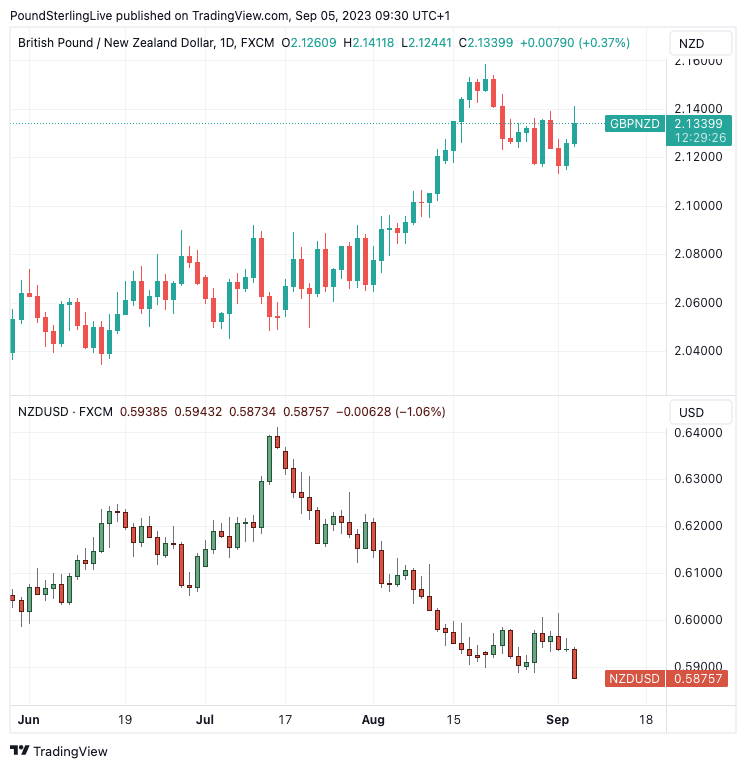New Zealand Dollar Dragged Down by AUD and China Woes
- Written by: Gary Howes
-

Above: New Zealand's timber exports are a major foreign exchange earner and highly dependent on Chinese demand. Image: Pine timber being exported from Wellington, New Zealand. Photo by James Anderson, World Resources Institute.
The New Zealand Dollar has been dragged lower by a faltering Australian Dollar, highlighting the interconnectedness of the Antipodeans and a reliance on China.
New Zealand dollars were sold following the release of softer-than-expected Chinese survey data for August that confirmed New Zealand's largest export market continues to struggle.
The Reserve Bank of Australia (RBA) meanwhile kept interest rates unchanged at its September meeting and gave little inclination it was determined to raise interest rates again in the near future, a development which also weighed on Reserve Bank of New Zealand rate hike expectations.
The Pound to New Zealand Dollar exchange rate shook off recent short-term weakness to advance by nearly half a per cent to 2.1359 after China's Caixin services PMI survey read at 51.6 in August, an undershoot of the 53.6 expected and a material slowdown on July's 54.1.
Above: GBPNZD (top) and NZD/USD.
The data confirms the Chinese economy remains caught in a lengthening slowdown, despite recent efforts by authorities to resuscitate it.
"Sentiment has turned downbeat again on China as fresh brushstrokes are painted on the picture of its slowing economy. The closely watched Caixin PMI data showed growth in the services sector decelerating by more than expected. Services had been a brighter spot in the economy, with hopes that consumers would continue to spend on trips out and education, but demand is turning more sluggish with any stimulus efforts to spur spending not hitting the mark," says Susannah Streeter, head of money and markets at Hargreaves Lansdown.
The New Zealand Dollar was down by a per cent against the U.S. Dollar as it hit fresh nine-month lows at $0.5872 with markets concerned a Chinese slowdown would further negatively impact the value of New Zealand's agricultural exports to China.
The weaker figures were driven by slowing new business orders with overseas demand recording the first drop since December 2022.
"The internal and external economic environments are becoming increasingly complex, adding to the urgency and necessity of implementing relevant supportive policies," said Caixin, who conducted the survey, in a note.
"China appears to be taking one step forward, but two steps back, as optimism one day turns to pessimism the next," says Streeter.
The RBA's decision to keep interest rates unchanged at 4.10% meanwhile hit the Australian Dollar and bolstered a view that peers across the Tasman sea are unlikely to raise interest rates again, further undermining the New Zealand Dollar's 'carry' credentials.
'Carry' refers to the dynamic whereby global capital flows from areas of lower interest rates to areas of higher interest rates, something New Zealand's Dollar has long benefited from.
"With the RBNZ on hold for the foreseeable future, NZD is likely past the point of peak support from monetary policy," says Lefteris Farmakis, an analyst at Barclays.
Above: Portfolio inflows (related to interest rate advantage) determines NZD valuations. Note: Flows are expressed as 4Q moving sums. Source: Haver Analytics, Barclays Research. Image courtesy of Barclays Research.
To be sure, New Zealand's base interest rate is at 5.5%, which is elevated relative to most developed market central banks, but because the hiking cycle ended earlier, markets have moved to price in rate cuts starting sooner.
In FX, the focus is increasingly turning from rate hikes to rate cuts, and the NZD is understandably at a disadvantage if markets reckon the RBNZ will be proactive in leading a rate-cutting cycle.
The RBNZ is unlikely to raise interest rates again given the slowdown in New Zealand's economic output - the economy was confirmed to be in recession at the turn of the year - and declining inflation.













